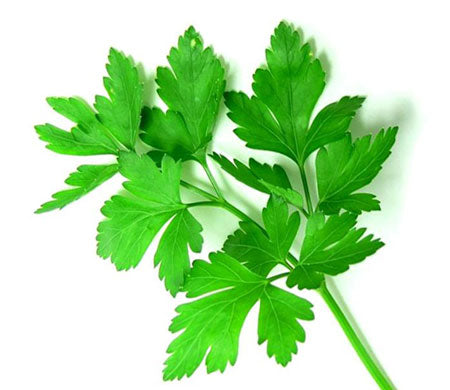Table of Contents
| 1. Introduction |
| 2. Ayurvedic properties |
| 3. Health Benefits & Uses |
| 4. Side Effects |
1. Introduction
Parsley is an erect, biennial, or short-lived perennial herb with a fleshy aromatic tap root and dark green shiny leaves that rise from a short stem. There are two groups of parsley – one with plain leaves and the other with curled leaves, commonly known as moss-curled. The leaves hold a high content of vitamins (A, C, and K), and β-carotene.
It has bright green, fragrant leaves, it adds color and flavor to any food we eat, and it is used to soothe various digestive complaints. In French, it is known as French persillade (a garlic parsley mixture), in Italy and Spain it is used for making delicious salsa Verde.
An analysis of parsley shows it to consist of moisture 74.6%, protein 5.9%, fat 1.0%, minerals 3.2%, fiber 1.8%, and carbohydrates 13.5% per 100 grams of edible portion. Its mineral and vitamin contents are calcium, phosphorus, iron, thiamine, riboflavin, niacin, and vitamin C. Its calorific value is 87. Parsley contains a glucoside apiin and an essential oil contains apoil. The fruit contains coumarin.

2. Habitat
Parsley’s scientific name is Petroselinum Crispum, and its other name is Prajmoda. It is native to southern Europe and is now grown throughout the tropics but tends to decay rather quickly near the equator. It is widely grown in the Philippines, Malaysia, East, and West Africa, Brazil, the Caribbean, and India.
3. Ayurvedic properties
1. Rasa (Taste): It has bitter (Tikta) and astringent (Kashaya) tastes.
2. Virya (Potency): It is cool in nature (Sheeta).
3. Vipaka (Post-digestive taste): The post-digestive taste is pungent (Katu).
4. Health Benefits & Uses
Parsley is rich in ascorbic acid and hence a good blood cleanser, it increases secretion and discharge of urine and relieves flatulence. Raw parsley juice has some metabolic properties for the normal functioning of the adrenal and thyroid glands. It has antifungal, antioxidant, anti-diabetic, hypotensive, hepato-protective, neuroprotective, analgesic, spasmolytic, immunosuppressant, anti-coagulant, anti-ulcer, and estrogenic properties.
Explore Herbs Powder
Here are some health benefits and uses of Petroselinum Crispum
Bad Breath
Parsley is an effective remedy for bad breath, boil 2 cups of water with coarsely chopped parsley sprigs and 2 or 3 whole cloves or a quarter tablespoon ground clove. Stir the mixture frequently while cooling. Strain and use as a mouthwash or gargle serval times a day.
Boils
The herb is beneficial in treating boils, steep parsley in boiled water till it is soft and juicy, and when slightly cooler but comfortably hot apply to the boils and wrap the area with clean muslin or linen.
Digestive Disorders
Parsley aids digestion and helps prevent the formation of gas in the stomach and intestines, it is one of the most popular remedies for indigestion. Taking a couple of sprigs of fresh herb or a quarter tsp of the dried herb with a glass of water is recommended. As fresh parsley is sometimes rather tough, it should be well-masticated.
Eye Disorders
Raw parsley juice mixed with carrot juice is effective in all ailments connected with the eyes and the optic nerves including weak eyes, ulceration of the cornea, cataracts, conjunctivitis, and ophthalmia or sluggishness of the pupil.
Genito-Urinary Disorders
According to Dr. R.D. Pope, who has done considerable research on the subject parsley, is “excellent for the genito-urinary tract, being of great assistance in the calculi of the kidneys and bladder, albuminuria, nephritis, and other kidney troubles. It has been used as an effective food remedy for dropsy.
High Blood Pressure
Parsley helps to maintain blood vessels, particularly the capillaries and arterial system, in a healthy condition. It is thus very useful in high blood pressure; it may be taken serval times a day as a beverage by simmering it gently in water for a few minutes.
Insect Bites and Wounds
The application of bruised parsley heals the bites and stings of insects; it is also very effective when applied on bruised and inflamed joints. It is the most effective cleansing suppuration when applied to open wounds.
Menstrual Disorders
The herb is an effective remedy for scanty menstruation, it also assists in the regularization of the monthly periods. This action results from the presence of apiol, a constituent of the female hormone estrogen.
Cramps because of menstrual irregularities are relieved and frequently corrected with the regular use of parsley juice, especially when combined with beet, carrot, and cucumber juices.
Other Benefits and Uses
Parsley can be added freely to salads and soups, parsley is palatable and easy to digest when used by itself or cooked with other green vegetables like cabbage or roots. It can be also dried and used, parsley can be taken as a beverage, simmering gently for a few minutes, and partaking of the water.
6. Side Effects of Petroselinum Crispum
Raw parsley juice is an extremely potent remedy, it should never be taken in quantities exceeding 60ml at a time, especially when mixed with a larger quantity of carrot or other raw vegetable juices such as celery, lettuce, or spinach.
Some General Precautions before Starting Parsley.
- Consult the doctor if you are breastfeeding.
- Consult the doctor if you are pregnant.
- Do not take parsley, if you are suffering from any kind of critical disease.
- If you are on diabetes or hypertension medication. Consult first with the doctor before consuming parsley.
- If you are on any supplements, vitamins, or herbal medication, consult the doctor before taking parsley.
Note: This post is about educating the benefits and uses of parsley, consult the Ayurvedic doctor before starting.
Explore Wholesale Herbs Powder



